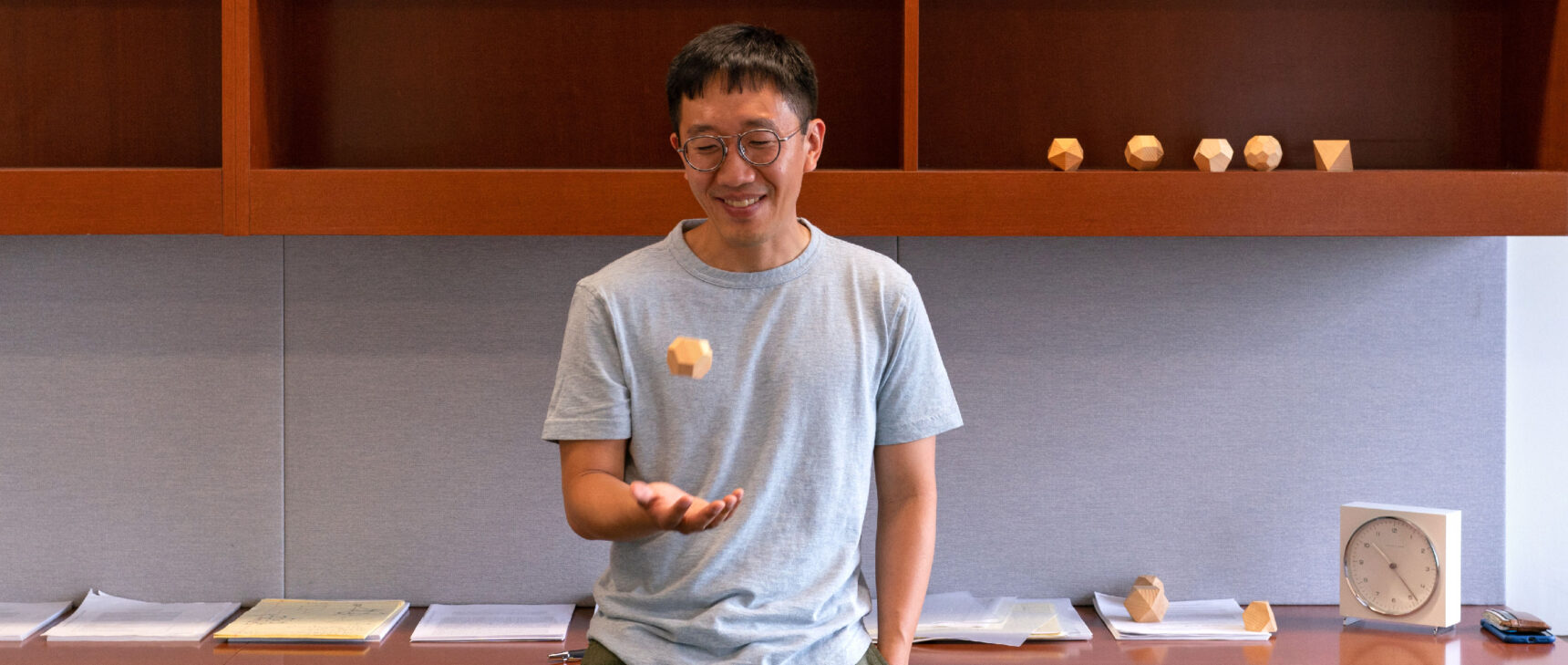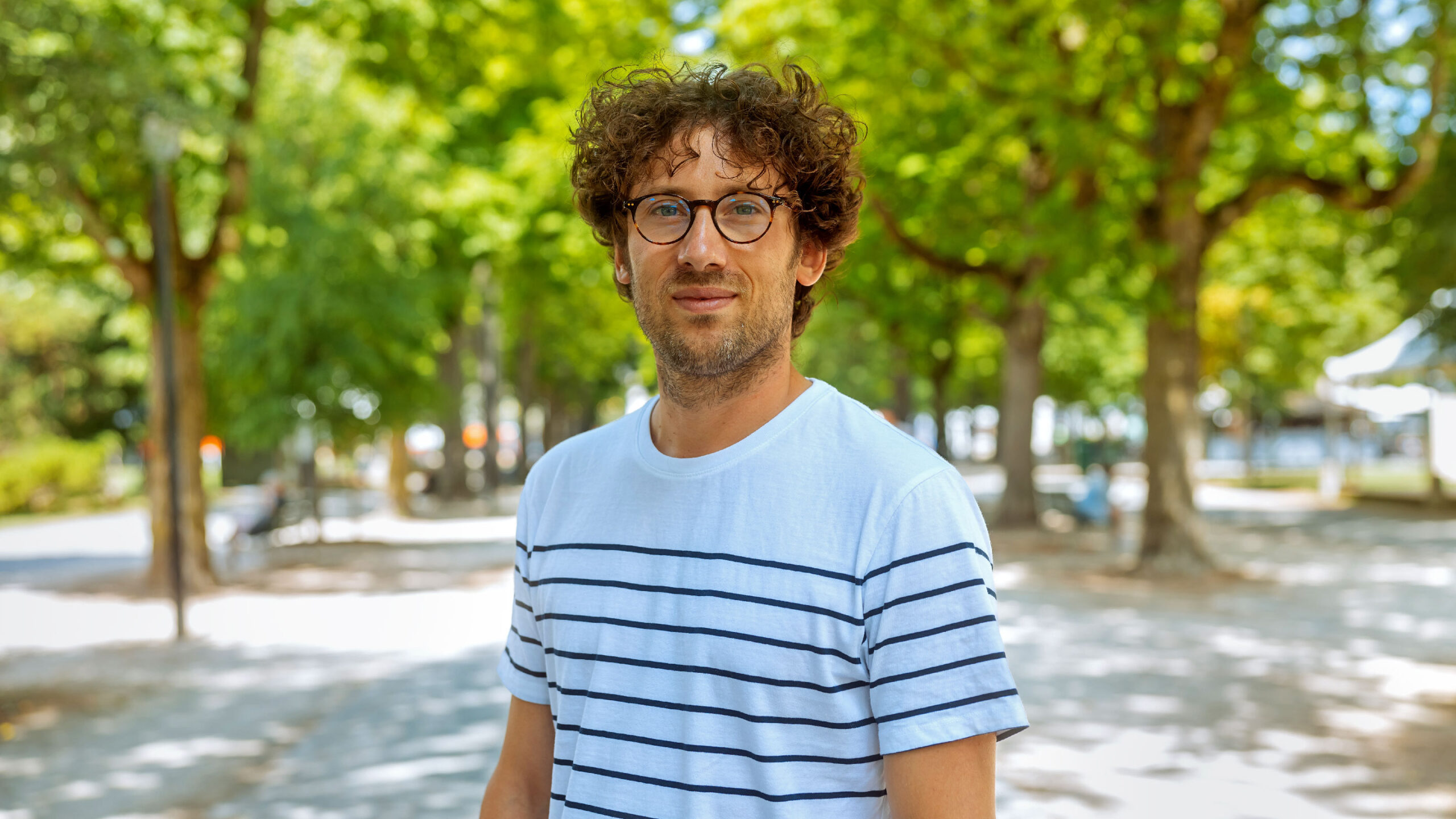
Hugo Duminil-Copin in Geneva’s Parc des Bastions. “Hugo is very, very optimistic,” said a colleague. “He wants things to work.”
Samuel Rubio for Quanta Magazine
Introduction
The math department at the University of Geneva is usually quiet and still — that is, except when voices boom down the hall from the office of Hugo Duminil-Copin, a not infrequent occurrence. “We were known within the department for shouting at each other all the time, because we would get very excited about what we were doing,” said Ioan Manolescu, a mathematician at the University of Fribourg and Duminil-Copin’s former postdoc. Sometimes, when their voices reached a crescendo, a neighboring professor might complain about the volume, and they’d have to shut the office door. “We were hated by our colleagues,” Duminil-Copin joked.
Still, he wouldn’t change anything about it. Those heated discussions, sometimes lasting for hours in front of a blackboard, are integral to how he does mathematics. He enjoys sharing his ideas with others, taking them apart and putting them back together as a group, being part of a team. His way of doing math is “very sporty,” said Wendelin Werner, a mathematician at the Swiss Federal Institute of Technology Zurich (ETH Zurich) — energetic, dynamic, collaborative.
Which makes sense: Duminil-Copin, 36, is a sporty guy. He hikes, bikes, swims and climbs, and it’s often on these excursions that he gets bursts of mathematical inspiration. His interest in a diverse range of activities also characterizes his work, where he has sampled tools from various fields in an ongoing effort to transform mathematicians’ understanding of phase transitions.
For that work, Duminil-Copin has now been awarded the Fields Medal, the highest honor in mathematics. He straddles the border between mathematics and physics, analyzing models of fluids flowing through a porous medium, like water coursing through coffee grounds. Such models, which involve the formation of connected clusters in random networks, can also represent the spread of a disease, the circulation of a rumor or the advance of a forest fire.
Before Duminil-Copin came on the scene, the study of these models — known as percolation theory — “was a bit stuck,” Werner said. A relatively simple type of percolation model was well understood (and had been by the 1990s), but most models were not. From the time he was a graduate student, Duminil-Copin has elucidated those more complex models and, in doing so, developed a more general theory of percolation.
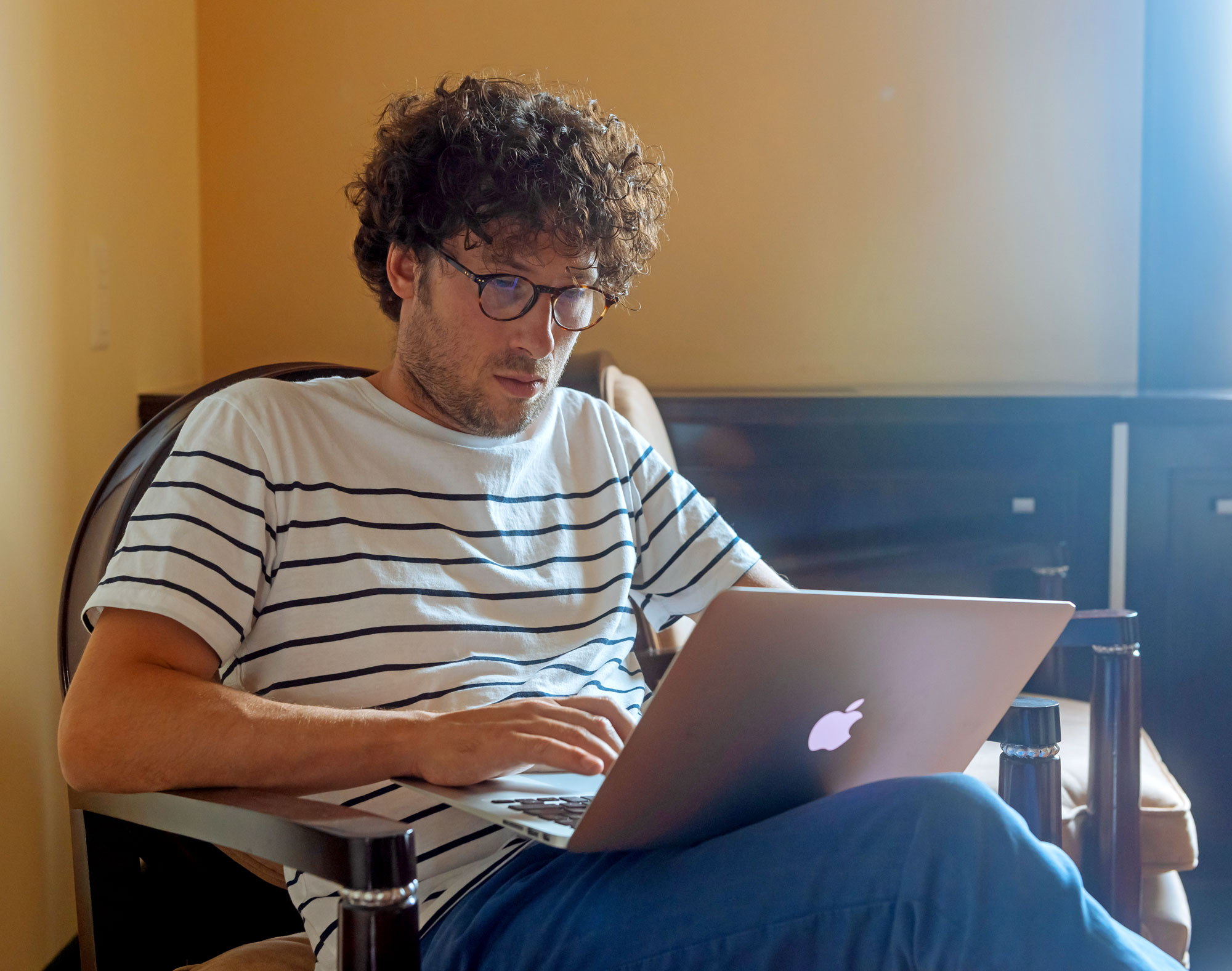
Samuel Rubio for Quanta Magazine
“Somehow, after he went through this field, you don’t recognize it,” Werner said. “Everything is easier, streamlined. The results are stronger. … The whole understanding of these physical phenomena has been transformed.”
Competitions Won and Lost
One of the first things people notice about Duminil-Copin is his enthusiasm. “He’s always very exuberant,” said Martin Hairer, a mathematician at Imperial College London who will deliver the laudatory lecture on Duminil-Copin’s work at the Fields Medal awards ceremony. Manolescu agreed. Duminil-Copin likes “to put [his] hands in it and do all the messy work, everything,” he said — even rewriting old proofs to make sure he understands them properly, and in a way that will best serve the problems he’s working on. “Hugo is very, very optimistic. He wants things to work.”
That energy, passion and optimism is evident not just in those loud discussions with colleagues, but in everything he does. It’s clear the moment you meet him: He can’t seem to sit still. While chatting in his office, he shifts in his seat, stands up and leans against the doorjamb, hands in pockets, or else against the arm of his chair, before sitting back down. He will drink two cups of coffee in less than two hours. (“The coffee consumption got worse and worse over time,” he said.)
All his life he’s been active. Growing up in a suburb an hour’s train ride from Paris, he spent his time playing guitar, hanging out with friends, and going camping, hiking and cross-country skiing with his parents and younger brother.
Most of all, he loved playing sports. It allowed him to focus his energy on something physical, to be part of a team, to test out different strategies. His father was a middle school gym teacher, his mother a dancer before she became an elementary school teacher. Math wasn’t his only or even primary interest. He was good at it, but he didn’t outstrip his peers so much that others took note. He played handball (a popular sport in Europe), and when considering which specialized high school he would attend, “I was hesitating between doing handball and actually doing more scientific studies,” he said. “At the time, I don’t think I was worse at sports than math.”
In the end, though, Duminil-Copin decided on a high school in Paris geared toward math and science, where “I was good at math, but there were better people, clearly,” he said. He recalls starting off as one of the worst students and gradually rising to the top of his class, only to be placed in a selective class in his second year, where he started at the bottom again. “I was like, whoa, that’s going to be a long year,” he said. But soon enough, he’d climbed back up in the ranks. Still, when he took the qualifying exam for the International Mathematical Olympiad — a math competition for high schoolers that many past Fields medalists have excelled at — he bombed. “I don’t have this kind of amazing problem-solving ability,” he said. Instead, for him, it was about working hard and being creative.

Duminil-Copin in his office at the University of Geneva.
Samuel Rubio for Quanta Magazine
“I never get discouraged. I’m always positive that I’m going to at least enjoy what I’m doing,” he said.
That attitude helped him just after high school, too, when he enrolled in a “classe préparatoire,” an intensive two-year program that prepares students to take the national entrance exams for specialized universities. “Most people were extremely stressed and extremely competitive,” said Manolescu, who met Duminil-Copin during that time. “He was much more relaxed.”
All of this added up to “a very normal childhood,” Duminil-Copin said, “which I think was very important for what came next. Many people don’t train that much for the fact that, actually, research is a very difficult thing for the mind. … You need to be very balanced to succeed in math. At least, that’s how I feel.”
The Flow
Duminil-Copin passed those entrance exams and ended up at the École Normale Supérieure in Paris, one of the top universities in France.
Until then, he wasn’t sure whether he would study physics or math. “I was kind of in between wanting to understand the world but at the same time needing very clear and self-contained answers,” he said. He loved physics — its reliance on physical intuition, the fact that physicists get to describe the universe — but he realized that he wasn’t content with explanations unless they were fully rigorous, capable of saying that something was truly known. “With a beautiful math proof, the right proof, you have a sense of completion,” he said. “I had a hard time finding that with physics.”
He ended up focusing on an area of math that hewed very close to physics and was motivated almost entirely by physical processes — the exact physical intuition he was drawn to from the get-go. “For me, percolation was intuitive,” he said. “My first love.”
To understand mathematical percolation, imagine an infinite grid of points connected by edges so that they form a checkerboard. For each possible edge, flip a weighted coin. If it lands on heads — which might happen with a probability of 1% or 20% or 80%, depending on how the coin is weighted — color the edge black. Otherwise, leave it alone. (In physical percolation, a black edge means the fluid can flow through that part of the system.) Mathematicians want to understand how clusters of connected black edges, called connected components, can materialize on the original lattice.
As you slowly raise the probability that any two points will be connected by a black edge, a phase transition occurs. That is, the overall behavior of the system changes abruptly, in much the same way that water freezes when the temperature dips below zero degrees Celsius. (In fact, “most systems actually undergo a phase transition,” Duminil-Copin said.) In this case, if you gradually increase the probability that the coin will land on heads, the system passes some critical value: Below that value, there is practically no chance that there will be an infinitely long connected component, and so our fluid will get stuck. Above it, there will be an infinite, continuous path through the system, and our fluid will flow.
Merrill Sherman/Quanta Magazine
Merrill Sherman/Quanta Magazine
Mathematicians want to understand how the system behaves below, at and above that critical point. But until around 2008, percolation theory was mostly limited to pinning down the details of the simplest model of percolation, called Bernoulli percolation. It wasn’t until Duminil-Copin made it his mission to extend that understanding to other percolation models that things began to change.
To hear him tell it, it all started with a swim and an idea that didn’t quite work.
As a doctoral student at the University of Geneva, he had been trying to solve a problem about percolation for months, to no avail. But while he was mulling over that problem — something he never does at a desk, preferring to walk or garden or just watch television instead — a different idea came to him. It wouldn’t work for the question he had been hoping to answer, but, he realized, it was exactly what he needed to solve a problem in a separate field: combinatorics.
“One day, I was swimming in the sea, and in like 10 minutes of swimming, I had a completely full proof of the other problem,” he said.
That Ph.D. result would almost immediately propel him to a professorship. He and Stanislav Smirnov, his adviser, considered the hexagonal lattice, a graph of edges and vertices that resembles a honeycomb. They wanted to count the number of self-avoiding walks — paths of edges that never visit the same vertex twice. The two mathematicians ultimately proved that there are $latex(\sqrt{2+\sqrt{2}})^N$ possibilities, where N is the number of steps in the path. They published their result in the Annals of Mathematics, widely considered the top journal in the field, in 2012.
A self-avoiding walk on the hexagonal lattice.
Merrill Sherman/Quanta Magazine
This and other graduate work made it “clear that he was not a usual student,” Werner said. On the night of his Ph.D. defense in 2012, he was offered a faculty position at Geneva. (He now has a joint appointment at the Institute of Advanced Scientific Studies in France.) By 2014, at the age of 29, he was a full professor.
Controlled Doubt
Despite his early successes — or perhaps because of them — Duminil-Copin considers himself allergic to academic hierarchies. Peers became his postdocs, but they say he always treated them as equals.
Go to Duminil-Copin’s website, and of the dozens of papers listed, there are only a couple where he’s the sole author. (For that reason, he also wishes that more awards, including the Fields Medal, were joint.) “It’s much more enjoyable when I share it with somebody,” he said. “I cannot even count the number of times I rushed into the office of one of my postdocs or one of my colleagues to explain some crappy idea that actually was literally wrong from the beginning.” In fact, he tends to discuss everything, not just mathematics, with his friends and collaborators. It helps him to process, to make sense of things.
“He would do this constantly,” said Manolescu, who is one such close friend and collaborator. “I’d be working with him, doing this for five hours. I would step out of his office and be completely dead. He would take a coffee and then have someone else over and talk about some completely different subject.”
Vincent Tassion, a mathematician at ETH Zurich and another of Duminil-Copin’s close friends and collaborators, described it as akin to having a good partner to climb a mountain with. It’s like “when you meet your soul mate,” he said. Over time, “we built our own language.” Sometimes they don’t even need to say anything. “A smile is enough.”
Tassion recalls that once, after finishing a proof with Duminil-Copin that both were particularly excited about, “we jumped into each other’s arms.” Their collaboration taught him that “math is something super intimate,” Tassion said. “You’re sharing … the way you think. It’s the most intimate thing you have.”
But for Duminil-Copin, this intensity, this full-time immersion in math as a collaborative sport, also helps him deal with his anxieties. He’s uncertain about almost everything he does. In graduate school, he could have a full proof in front of him, completely written out, and he’d still doubt it for months. Having collaborators to check his work puts him more at ease. Despite his obvious intelligence and charisma, “I am not so self-confident,” Duminil-Copin said.
By his own admission, he tends to overthink things. And not just when it comes to math — everything. For instance, he recently oversaw the planning and construction of his new house, which he shares with his partner Séverine, their 1-year-old daughter and their dog. As it was built, he would discuss various possibilities with the workers, constantly wanting to modify even tiny details. “I was completely, completely obsessed,” he said. “The house could be half as beautiful as it is, and it would be infinitely sufficient already.”
That’s very much what proof-writing looks like for him: constantly making improvements, and getting obsessive about the details.
Obsessive attention to detail has its advantages. The family’s new home is constructed on the slope of a mountain, giving them a view of all of Geneva — including the lake and its famous fountain. His office there is spacious; the floor is partly covered by hexagonal tiles that call to mind both his doctoral work and an important process in percolation theory. (The design was intentional.)
“I like that things are done in the proper way,” he said — that, once finished, they’re truly complete. “For this house, for instance, I won’t have to move again.” Once more, the language he uses mirrors how he describes his mathematical work: Proofs done right give him a sense of completion.
Sitting on the patio outside — there are several outdoor spaces where he can pause and think — Duminil-Copin takes in his surroundings. “I love this place,” he said. “It’s an invitation to contemplate things.”
“When you look at this,” he continued, motioning to the Alpine peaks rising behind him and the lake spreading out in the distance below, “it puts things in perspective. … There are mountains around that have been there for millions of years. They will be there in millions of years. This is something that reassures you of how small you are.”
Despite his easygoing manner, he says that he needs to feel like he’s in control. That goes for building the new house (something he has no expertise in) and now raising a child. Even the press coverage he’s sure to receive for the Fields Medal makes him somewhat uncomfortable; it’s another thing he can’t control. Living in the mountains helps to make things seem more tractable.
So does math, which he also uses as a healing mechanism. There, he can exercise more control, because “I master what I’m doing,” he said. Besides, the math he does is so removed from the realm of daily life that “it’s something very reassuring, because it’s very pure.” And the intensity it requires allows him to forget everything else.
A Sharp Distinction
Duminil-Copin has revolutionized our mathematical understanding of percolation theory, but from a physicist’s perspective, much of what he has proved has been known for years, if not decades, because of experimental observations of percolation in real-life scenarios. “Everybody knows what the answer is going to be, but nobody knows how to prove it,” Werner said.
Duminil-Copin’s work on percolation can be divided into three parts: identifying the critical point at which the phase transition occurs; characterizing what’s happening in the system above and below that point; and understanding what’s actually transpiring at that point.
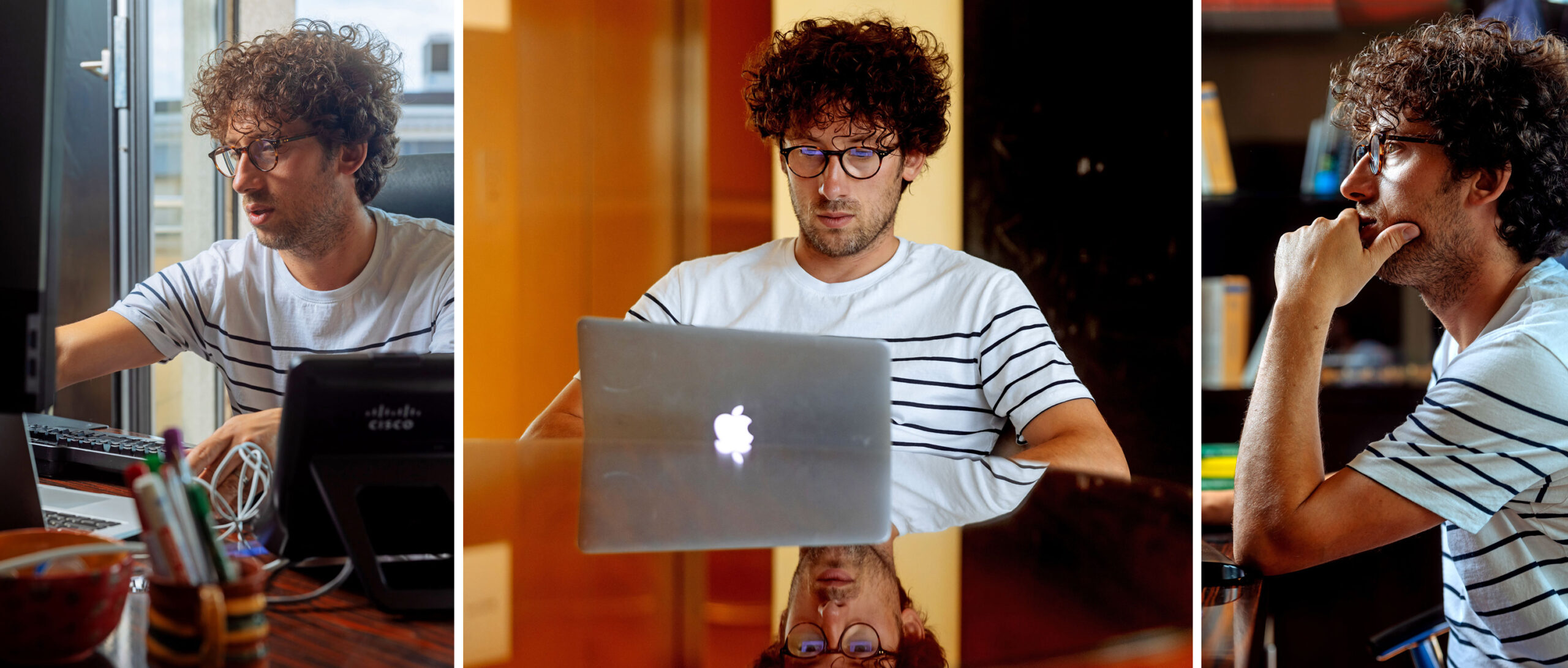
Samuel Rubio for Quanta Magazine
Much of this was already known for Bernoulli percolation, the simple model in which the presence or absence of a black edge is determined through independent coin flips. But for most percolation models, that’s not the case. Instead, the existence of a black edge in one part of the lattice will influence whether there are black edges elsewhere. Due to these long-range dependencies, such percolation models are much more difficult to understand.
But they are also better models of reality. Paths of black edges can represent correlations or communication channels between different parts of a natural system, like a magnet. In fact, Duminil-Copin has often used dependent models of percolation to gain insights into the Ising model, which is used to study the behavior of ferromagnets and related systems.
Before he could do so, however, he had to make sense of those dependent percolation models. One of his first successes was in identifying the critical point — the probability threshold at which the phase transition occurs — for a large class of dependent percolation models in two dimensions. The formula that he and the mathematician Vincent Beffara obtained also produced the already known answer for Bernoulli percolation. “This was in some sense the beginning of the story,” Duminil-Copin said.
He next wanted to understand the behavior of the system above and below the critical point. Below it, the connected components on the lattice are all finite. But how small are they? Together with Tassion and Aran Raoufi, Duminil-Copin proved that they’re tiny. The probability of finding a large connected component — a vast but finite island of connected black edges — plummets rapidly as the desired size of that island gets larger. That is, the probability that two vertices are in the same connected component decreases exponentially when you consider points that are farther and farther away from each other.
Similarly, above the critical point, the finite connected components that exist alongside the infinite one are also tiny.
This property is called “sharpness,” and Duminil-Copin and his colleagues proved it for a major class of dependent percolation models in all dimensions, using tools from analysis and computer science. For the purposes of expanding percolation theory, this result (which was also published in Annals) “was one of the cornerstones of what I was aiming toward for a long time,” he said. That’s because a lot of other proofs relating to the behavior of dependent percolation models above and below the critical point assumed this property as a conjecture. As a result, once Duminil-Copin had his proof, other results offering insight into certain quantities and features (such as the shape of the connected components) followed immediately.
Merrill Sherman/Quanta Magazine
Merrill Sherman/Quanta Magazine
Of course, perhaps the most natural question to ask is what happens at the critical point itself, the precise moment of the phase transition. For mathematicians, understanding that “is the most challenging part, the most mysterious part,” Tassion said. “It’s the object of most of the open problems today.”
When the infinite connected component emerges, it might gradually increase in density, invading the whole space bit by bit. In that case, the percolation model is said to be “continuous” at the critical point. But sometimes, that density might suddenly jump in a “discontinuous” way, with the infinite component permeating the whole system so that the fluid doesn’t just find a path but can flow practically everywhere as soon as the phase transition occurs.
This distinction is essential to understanding a given process. The phase transition from ice to water, for instance, is discontinuous. As a result, at zero degrees, more energy must be added to the system for some time before the transformation actually occurs. (This discontinuity also helps explain other properties, like sudden changes in volume.)
For Bernoulli percolation, the transition is known to be continuous. But for dependent percolation models, physical experiments and intuition indicate that it’s sometimes continuous and sometimes discontinuous. Duminil-Copin sought to disentangle that. He and his colleagues first showed that, for a class of dependent percolation models in two dimensions, the phase transition is always continuous in a certain regime (related to another parameter associated with the model). A year and a half later, he and another set of mathematicians proved that the same class of models has a discontinuous phase transition in a complementary regime.
Using this broader understanding of dependent percolation models — of what’s happening before, at and after their critical points — Duminil-Copin has since been able to extend his theory further, including to other models like the Ising model. “Basically half of the main open questions [in the field] were solved by Hugo,” Werner said.
Worked Out
For Duminil-Copin, his research is only a fraction of what he actually does as a mathematician. “He’s very aware of his sense of duty for the community,” Werner said. “He’s a very, very responsible citizen.”
He thinks carefully about how his behavior — how he talks, teaches, writes — affects others. In collaborations, “he’s extremely generous,” Tassion said. “He makes space for you … [and] has the ability to make you feel clever. It’s very motivating.”
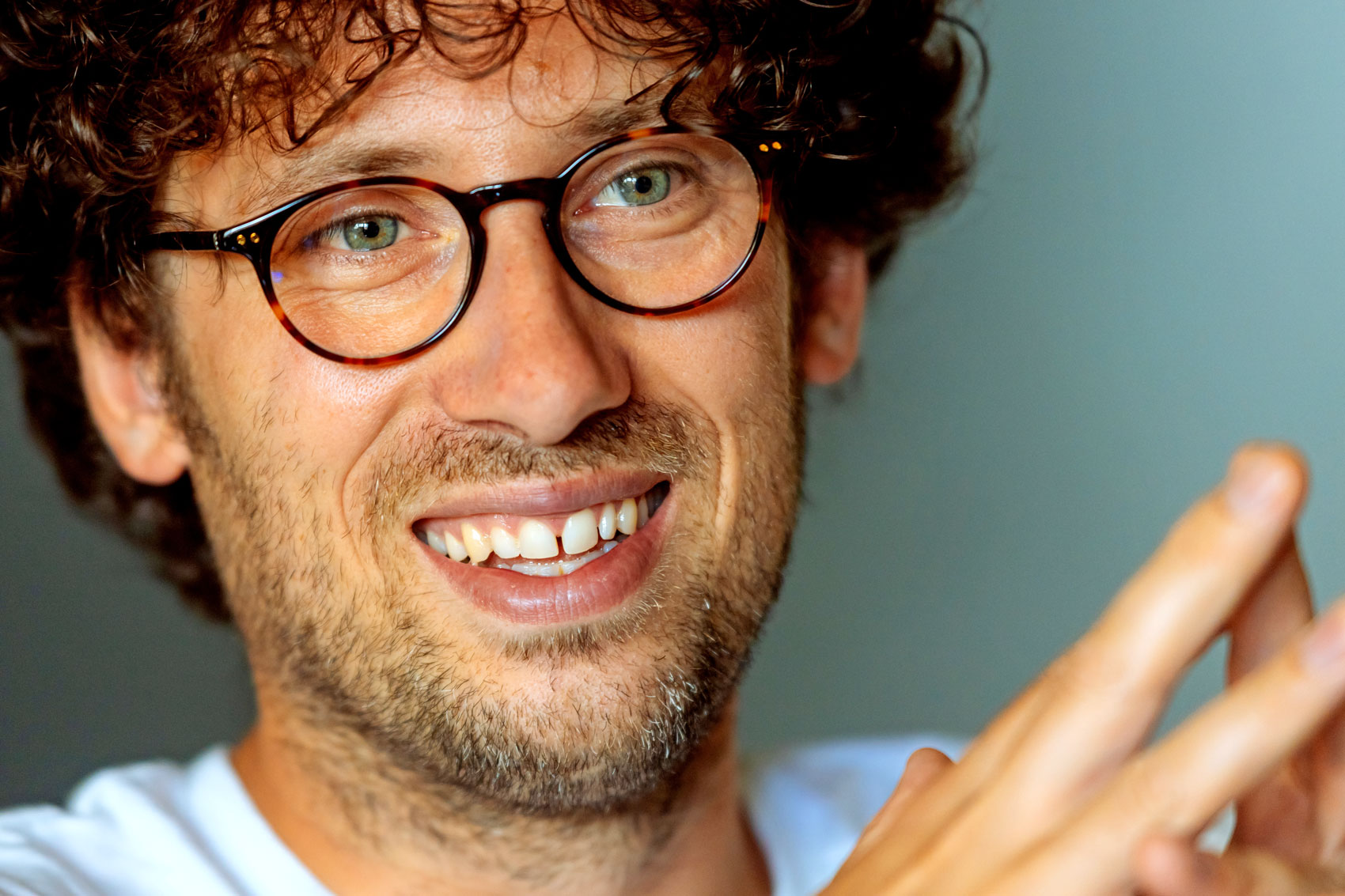
“I am not so self-confident,” Duminil-Copin said, but “I’m always positive that I’m going to at least enjoy what I’m doing.”
Samuel Rubio for Quanta Magazine
To Duminil-Copin, writing a clear paper that’s as general and elegant as possible is a matter of respect: for the mathematicians who will spend time reading it, and for those who might want to build on it or use it in their own work. That might mean spending years refining a proof, distilling it to its essence and cutting away unnecessary or confusing parts. Or, as he did in one major work, simplifying a preexisting proof in a way that would transform how new students learned about a key part of the field. “He genuinely cares about actually explaining stuff, and not just being the first guy who actually proved it,” Hairer said.
“You have a responsibility,” Duminil-Copin said. The same applies to teaching, participating in various committees, doing editorial work and writing recommendation letters. At times, he’ll prioritize these kinds of tasks to his own detriment: Even if he’s already overwhelmed, activities that involve other people come first.
Now that he’s been awarded the Fields Medal, he feels as though he has been given another job: to act as a sort of ambassador, properly showing what research in math is like and why it’s important. “You have no choice but to create this kind of example,” he said.
Still, in the end he always gravitates back to doing math. He hopes to write a new chapter on dependent percolation models in two dimensions by showing that they satisfy certain symmetries at their critical point — that is, that they’re “conformally invariant.” If he and his colleagues can prove that these symmetries exist, mathematicians will be able to extract a wealth of other information about the models. “You’d get to know everything about the model, basically,” Duminil-Copin said. “So for me, it’s the last step in 2D.”
In work posted in late 2020, he and his co-authors took a major step toward showing conformal invariance. But Duminil-Copin thinks that earlier this year, they may have gotten the breakthrough they needed. “It’s not clear it’s going to be sufficiently strong to get a new result,” he said. But he’s excited, and he’s looking forward to having time to think about it more deeply. “It’s a problem that became very dear to me.”



